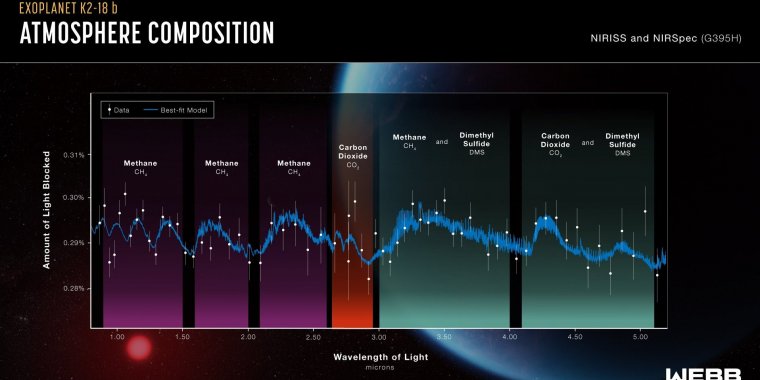| News / Space News |
Webb Discovers Methane, Carbon Dioxide in Atmosphere of K2-18 b
A new investigation with NASA’s James Webb Space Telescope into K2-18 b, an exoplanet 8.6 times as massive as Earth, has revealed the presence of carbon-bearing molecules including methane and carbon dioxide.

Spectra of K2-18 b display an abundance of methane and carbon dioxide in the exoplanet’s atmosphere, as well as a possible detection of a molecule called dimethyl sulfide (DMS). Photo: NASA, CSA, ESA, R. Crawford (STScI), J. Olmsted (STScI)
Webb’s discovery adds to recent studies suggesting that K2-18 b could be a Hycean exoplanet, one which has the potential to possess a hydrogen-rich atmosphere and a water ocean-covered surface.
K2-18 b orbits the cool dwarf star K2-18 in the habitable zone and lies 120 light-years from Earth in the constellation Leo. Exoplanets such as K2-18 b, which have sizes between those of Earth and Neptune, are unlike anything in our solar system.
This lack of equivalent nearby planets means that these ‘sub-Neptunes’ are poorly understood, and the nature of their atmospheres is a matter of active debate among astronomers.
The suggestion that the sub-Neptune K2-18 b could be a Hycean exoplanet is intriguing, as some astronomers believe that these worlds are promising environments to search for evidence for life on exoplanets.
The abundance of methane and carbon dioxide, and shortage of ammonia, support the hypothesis that there may be a water ocean underneath a hydrogen-rich atmosphere in K2-18 b.
These initial Webb observations also provided a possible detection of a molecule called dimethyl sulfide (DMS). On Earth, this is only produced by life.
The bulk of the DMS in Earth’s atmosphere is emitted from phytoplankton in marine environments.
While K2-18 b lies in the habitable zone, and is now known to harbor carbon-bearing molecules, this does not necessarily mean that the planet can support life.
The planet's large size — with a radius 2.6 times the radius of Earth — means that the planet’s interior likely contains a large mantle of high-pressure ice, like Neptune, but with a thinner hydrogen-rich atmosphere and an ocean surface.
Hycean worlds are predicted to have oceans of water. However, it is also possible that the ocean is too hot to be habitable or be liquid.
Characterizing the atmospheres of exoplanets like K2-18 b — meaning identifying their gases and physical conditions — is a very active area in astronomy.
However, these planets are outshone — literally — by the glare of their much larger parent stars, which makes exploring exoplanet atmospheres particularly challenging.
The team sidestepped this challenge by analyzing light from K2-18 b's parent star as it passed through the exoplanet's atmosphere.
K2-18 b is a transiting exoplanet, meaning that we can detect a drop in brightness as it passes across the face of its host star. This is how the exoplanet was first discovered in 2015 with NASA’s K2 mission.
This means that during transits a tiny fraction of starlight will pass through the exoplanet's atmosphere before reaching telescopes like Webb.
The starlight's passage through the exoplanet atmosphere leaves traces that astronomers can piece together to determine the gases of the exoplanet's atmosphere. (NASA)
YOU MAY ALSO LIKE





